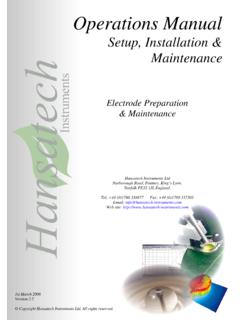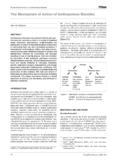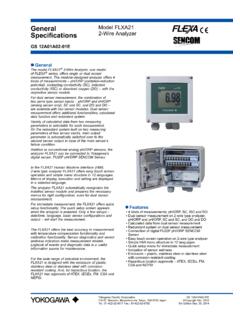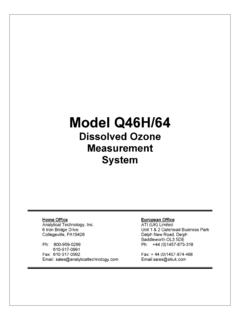Transcription of Method 1683: Standard Oxygen Uptake Rate in …
1 EPA-821-R-01-014 January 2001 Method 1683 Specific Oxygen Uptake Rate in Biosolids Draft January 2001 Environmental Protection Agency Office of Water Office of Science and Technology Engineering and Analysis Division (4303) 1200 Pennsylvania Ave. NW Washington, DC 20460 Method 1683 Acknowledgments This Method was prepared under the direction of William A. Telliard of the Engineering and Analysis Division (EAD) in conjunction within the Environmental Protection Agency s (EPA s) Office of Science and Technology (OST). This Method was prepared by DynCorp Information and Enterprise Technology under EPA Contract 68-C-98-139. Disclaimer This draft Method has been reviewed and approved for publication by the Analytical methods Staff within the Engineering and Analysis Division of the Environmental Protection Agency.
2 Mention of trade names or commercial products does not constitute endorsement or recommendation for use. EPA plans further validation of this draft Method . The Method may be revised following validation to reflect results of the study. This Method version contains minor editorial changes to the February 1999 version. EPA welcomes suggestions for improvement of this Method . Suggestions and questions concerning this Method or its application should be addressed to: Maria Gomez-Taylor Engineering and Analysis Division (4303) Environmental Protection Agency 1200 Pennsylvania Avenue, NW Washington, DC 20460 (202) 260-7134 Draft- January 2001 ii Method 1683 Note: This Method is intended to be performance based. The laboratory is permitted to modify or omit any steps or procedure, provided that all performance requirements in this Method are met.
3 The laboratory may not omit any quality control analyses. The terms shall , must , and may not indicate steps and procedures required for producing reliable results. The terms should and may indicate optional steps that may be modified or omitted if the laboratory can demonstrate that the modified Method produces results equivalent or superior to results produced by this Method . Draft- January 2001 iii Method 1683 Method 1683 Specific Oxygen Uptake Rate in Biosolids Scope and Application This Method is applicable to the determination of the specific Oxygen Uptake rate (SOUR) (Section ) in biosolids (Section ) treated in an aerobic process. This Method is for use in the Environmental Protection Agency s (EPA s) data gathering and monitoring programs under the Clean Water Act, the Solid Waste Disposal Act, the Resource Conservation and Recovery Act, the Comprehensive Environmental Response, Compensation, and Liability Act, and the Safe Drinking Water Act.
4 To confirm approval of this Method for use in compliance monitoring programs, consult the appropriate sections of the Code of Federal Regulations (Reference ). This Method was developed by integrating the analytical procedures contained in Standard Method 2710 B (Reference ) with the recommendations described in the EPA Document Environmental Regulations and Technology: Control of Pathogens and Vector Attraction in Sewage Sludge (Reference ) and the quality control (QC) procedures necessary to ensure the validity of analytical results. This Method is associated with EPA Method 1691: Municipal Biosolids Sampling Guidance (Reference ). This Method may not be applicable to sewage sludge (Section ) with higher than two percent solids or to sewage sludge digested at temperatures lower than 10EC or higher than 30EC.
5 Microorganisms in sewage sludge use Oxygen as they consume organic matter. The level of microbial activity in sludge is indicated by the microorganisms Oxygen Uptake rate. High Oxygen Uptake rates indicate high microbial activity and high organic matter content; low Oxygen Uptake rates indicate low microbial activity and low organic matter content. This Method is performance-based. The laboratory is permitted to omit any step or modify any procedure, provided that all performance requirements in this Method are met. Requirements for establishing Method equivalency are given in Section Each laboratory that uses this Method must demonstrate the ability to generate acceptable results based on the performance criteria given in Section 17.
6 Summary of Method The sample is maintained at the temperature of the digester from which it was drawn, from the time of collection until the end of analysis. The sample is kept under aeration if the test cannot be run expeditiously. The total solids content (Section ) of the sample is determined on an aliquot (Appendix A). The sample is mixed, and the concentration of dissolved Oxygen (DO) (Section ) in the sample is increased by aeration. An aliquot of the sample is placed in a biological Oxygen demand (BOD) bottle and kept well mixed. Using an Oxygen -sensing probe, a manometer, or respirometer, DO is recorded periodically over a 15-minute period, or until DO becomes rate-limiting (Section ). Draft- January 2001 1 Method 1683 The Oxygen consumption rate (Section ) is calculated as the absolute value of the slope of the linear portion of the DO versus time curve when an Oxygen probe is used, or from calculations as specified by the manufacturer of the manometer or respirometer.
7 The SOUR is obtained by dividing the Oxygen consumption rate by total solids. The SOUR for the temperature at which the aerobic digestion is occurring in the treatment works is corrected to 20EC, as a standardization for reporting purposes. Definitions Definitions for terms used in this Method are given in the glossary (Section 18). Interferences SOUR determination is sensitive to the time lag between sample collection and analysis. To minimize changes in the sample due to microbial activity over time, samples should be analyzed as soon as possible after collection. The sample should be transported to the laboratory expeditiously and kept under aeration if the SOUR test cannot be run immediately. The sample must be kept at the temperature of the digester from which it was drawn.
8 This Method may not be applicable to samples with total solids above two percent, samples that remain heterogenous after mixing, and samples that contain solids that do not remain in suspension and settle to the bottom of the container. In these cases, aeration and mixing are difficult, and the Method yields inconsistent results because samples can not be kept well mixed during analysis. Although adequate mixing is essential, the samples must not be blended with a homogenizing instrument. Homogenization is likely to change sample characteristics and the rate of Oxygen Uptake significantly. The results of the determination of SOUR are extremely sensitive to temperature variations. It is essential that the SOUR test be performed at the temperature of the digester from which the sample was drawn, because dissolved Oxygen concentration and microbial activity are influenced by temperature.
9 Poor precision is obtained when duplicate determinations are not made at the same temperature. The SOUR for the sample reflects the temperature of the digester from which it was drawn. This value is corrected to 20EC by using Equation 3. The correction is valid only for digester temperatures between 10EC and 30EC. The fixed solids (dissolved inert mineral solids) (Section ) in the wastewater in which the sludge particles are suspended do not exert an Oxygen demand and should not be part of the total solids in the SOUR determination. Ordinarily, the fixed solids are such a small part of the total solids that they can be ignored. If it is suspected that there is a high level of fixed solids in the wastewater (a ratio of fixed to total solids greater than ), the volatile solids content (Section ) should be determined with Method 1684 (Reference ) and be used instead of total solids in the calculation of SOUR (Equation 2).
10 Aeration of the sample to at least 5 mg/L DO is critical. Low DO at the start of the test may limit Oxygen Uptake and will be indicated by a decreasing rate of Oxygen consumption as the test progresses. Such data must be rejected as being unrepresentative of SOUR and the test must be repeated with higher initial DO levels. The sample should be aerated again following procedures in Section Draft- February 1999 2 Method 1683 For samples suspected to contain high levels of oxidizable materials: It is important not to oversupply samples with Oxygen during initial sample aeration. Prolonged aeration may lead to oxidation of significant portions of the organic matter in the sample and may alter the characteristics of the sample.















